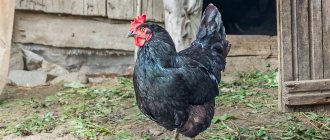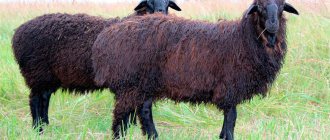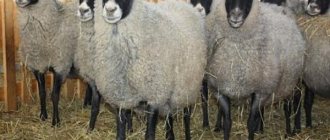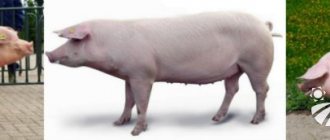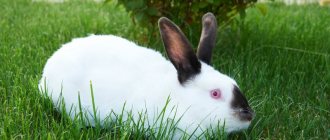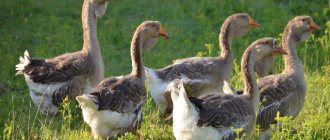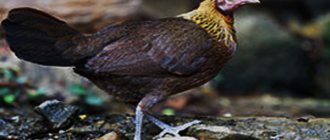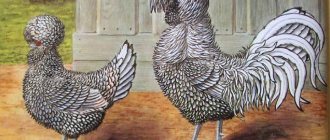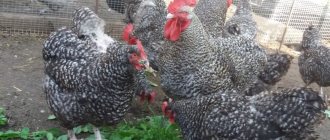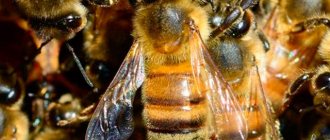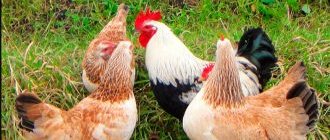Several decades ago, the livestock world learned about a new breed of sheep called Dorper. The cost of this type was quite high. But, even despite this, the animals gained great popularity and became common among farmers. Dorper is grown only for meat, because large individuals can reach up to 1.5 centners in weight. Many may be surprised by the appearance of animals, because they are really very different from all their relatives.
What is the origin of this breed?
This type of sheep has roots in South Africa. At the beginning of the last century, local livestock breeders began breeding a breed that could perfectly withstand the extreme conditions of that area. The arid climate was not suitable for the “classical” types of sheep; even unpretentious breeds could not withstand such conditions.
In order for the animal to adapt to such African conditions, breeders decided to cross two breeds of sheep that have the qualities to survive in a difficult climate. One of the ancestors were Dorset Horn sheep, and the second were black-headed Persian rams. Thanks to the names of these species, the word “dorper” appeared. In addition to the described breeds, several other useful species also made their genetic contribution. They were able to successfully complement the phenotype of the bred breed.
Ultimately, the livestock breeders still managed to achieve their goal, because Dorpers were able to adapt to conditions in which no other breed could exist. In addition, this type of sheep not only survives in the hot climate of South Africa, but also produces meat and milk. This is important for farmers who decide to start raising sheep.
Origin
This breed was bred in the thirties of the 20th century, and the Dorper’s homeland is South Africa. The variety was obtained by crossing Dorset and Persian sheep, each of which is characterized by unpretentiousness in maintenance and good productivity. Representatives of Dorpers adopted fertility from Dorsets. The breed owes its lack of hair and non-standard color to its Persian ancestors. At first, the breed became widespread in Australia, and then was brought to the USA and Great Britain. And only after a while the dorper appeared in Russia.
The breed was officially registered in 1930. The name “Dorper” was not obtained by chance: the word is formed from parts of two names – Dorset and Persian (the ancestors of the Dorpers).
Is the breed worth the price?
Many novice farmers, when they learn about the cost of dorper sheep, wonder whether it is worth spending that kind of money and whether it will definitely pay off. Experienced livestock breeders who are familiar with Dorpers know that the price of young animals corresponds to the value of the breed.
Among the main qualities of animals is the speed of reproduction. An adult ewe can give birth to up to 5 lambs at a time, and childbirth is most often easy and almost never complicated. Thus, to obtain offspring you will not even need the help of a person, much less a veterinarian. Already from the age of eight months, sheep become sexually mature and can bear offspring. Newborn lambs are resistant to environmental conditions and almost all survive to adulthood.
Thanks to the work of breeders, Dorpers have developed good resistance to parasites at the genetic level. This relieves the owners from fighting skin and intestinal helminths. It is required to carry out preventive measures every six months.
Since Dorpers are a meat breed, many people are interested in how quickly they gain weight. Already at the age of one month, the lamb reaches a body weight of up to 25 kilograms. Adults easily gain up to 100 kilograms. And all this despite the fact that dorpers can feed on scarce pastures.
Maintenance and feeding
Although the animals were bred on the African continent and, as a result of selection, received resistance to living in constant heat, sheep can easily tolerate thirty-degree frost. Animals are able to acclimatize to almost any conditions and accept the food supply available there. They can be selected for breeding on very poor pastures. Even the worst feeding conditions in Russia and Europe significantly exceed the quality of grasses in the dried African savannah.
A sheep is able to live, gain weight and produce healthy offspring solely on pasture. If there is a shortage of harvested hay, the flock can even be driven out onto the snow, under which the animals will always find food for themselves.
On non-sheep farms, a few Dorpers can sometimes be found free-ranging and kept as weed control. Animals move around the territory of the enterprise and gnaw away the emerging grass. Thanks to their polled nature, the danger of sheep attacking people is not too dangerous.
Despite the ability of sheep to live for several days without drinking, you should not resort to such extreme maintenance, because under good conditions the profitability of farming increases significantly. Caring for these animals is very simple compared to other breeds, so providing food and water will be quite fair.
When keeping Dorpers, you don't have to worry about cutting them. Animals have developed natural resistance to parasites. They don't get fleas and ticks as often because of their short hair. In addition, internal parasites are also rare. Preventive deworming is carried out only once a year. It is recommended to keep animals in a closed sheepfold during severe frosts.
What is the value of the products obtained from this breed?
Dorpers are valued not only for their unpretentiousness and ability to survive in harsh and arid conditions. In addition, the sheep breed also produces valuable products.
Important! Dorper meat is dietary. The peculiarities of feeding make it possible to obtain meat with thin, even veins, although in ordinary lamb the fat is located in layers.
This product will also please you with its taste, since the meat itself is tender and tasty. Many people say that such lamb is tasty and refined. The product is also suitable for those who do not like the special “mutton” taste in meat. This is not the case here; the meat is neutral in both smell and taste. From one large ram you will get more than half a centner of meat.
In addition to meat products and offal, you will also receive leather. Dorper leather is easy to tan and is of high quality. From such raw materials, things are obtained that are highly valued.
Sheep dairy products are also of high quality. In terms of productivity, Dorpers are inferior to other varieties of sheep, but they will still be able to please their owners.
Dorpers are suitable for breeding in dry conditions. They are an advantageous breed.
Description of appearance
This breed of sheep breaks all stereotypes about what lambs look like. It is a meat breed and was bred for breeding in hot conditions. Therefore, sheep have practically no wool. Perhaps this is the main feature of this breed.
In addition, the appearance of dorpers can be characterized by the following parameters:
- The appearance of Dorpers is neat and tidy. The fur of these animals is not very developed and has such a length that it does not need cutting. The fur consists of guard hairs and undercoat, which are rough and tough. The hairline is unevenly distributed, the legs and belly of the sheep are almost naked, and the back, sides, neck and head are covered with a thicker “fur coat”.
- Dorpers are large in size, this breed is more massive than most other lambs. The animal's legs are short, all muscle groups are developed, which gives it a massive and stocky appearance.
- The coloring of the breed is interesting. The whole body has sparse white fur, but the neck and head are black. There is no hair on the face, but on the forehead and behind the ears the hair curls in small curls. Some individuals have a pure white color, this is due to the amount of Persian sheep in the family. This breed is characterized by a black head color.
Reproduction
Because Dorper babies are born very small, sheep of this breed usually lamb without complications and quickly. Of course, the stall where the queen will lamb must be clean and dry. Sheep and offspring should be fed as best as possible. If there are not enough vitamins in the mother's milk, the lambs may get sick. Apart from ensuring quality feeding, the farmer does not need to take any further actions during this period. The maternal instinct in Dorper sheep is well developed, and they take very good care of the lambs.
The young animals of this breed develop quickly. Within a few hours after birth, the lamb is able to jump and run around the stall. Therefore, queens and offspring are kept separately for no more than 2 weeks. Lambs can be finally weaned from their mother at three months of age.
How does breeding happen?
Despite its South American origin, this breed is suitable for breeding in other regions. Dorpers have taken root on other continents. Breeding attempts were made in the northern part of America. Even to Australia, farmers brought this type of sheep because they found this breed attractive for farming.
In Russia and neighboring countries, dorpers have not yet gained popularity due to the high cost and difficulties with transportation. To create a farm with this breed you need considerable capital. Such a project was developed for one city in Russia, but, unfortunately, it did not come to fruition.
Important! It is practiced to purchase materials for fertilization and inseminate females with the sperm of purebred Dorpers.
In their homeland, free mating takes place. Females reach sexual maturity later than males. In one lamb a sheep produces about 5 lambs. The anatomy of the adult and the structure of the fetal skull do not lead to problems with childbirth. It is rare to resort to the help of a veterinarian if the animal has any anomalies in the structure of the reproductive tract. The offspring are distinguished by their endurance and vitality. 90-100% of lambs born survive to adulthood.
Care
Ideal for dorpers is pasture housing, when the animals spend most of the year on pastures or in large fenced enclosures. Mobile ones are best. As the grass in the fenced area dries out, the fence is dismantled and moved to a neighboring area.
Maintenance of Dorpers
With the onset of cold weather, animals are transferred to sheepfolds. The premises should be spacious, bright, without drafts, to which Dorpers are very sensitive. Ventilation and heating system must be required. In group stalls, one individual should have at least 1.5 sq.m. area, in individual ones - not less than 2.5. The queen with lambs needs even more space. With one lamb - 3.2 sq.m., with each subsequent lamb the total area is increased by another 0.7 sq.m.
Feeders and drinkers are built in the shape of long troughs. Their length should be sufficient so that all the inhabitants of the stall can eat or drink at the same time without jostling each other. Feeders in the uterine compartments are placed higher than usual, so that dairy lambs cannot jump inside.
Sheep near the feeder
However, even at sub-zero temperatures it is necessary to provide animals with the opportunity to walk. Domestic breeders write on forums that the Russian winter is not a hindrance for Dorpers, even despite the lack of wool. At a temperature of minus 15 degrees Celsius, Dorpers can be outside along with other domestic sheep; at a temperature of -20 degrees Celsius, the sheep leave the barn for half an hour and come back together.
Dorpers in the pasture
Video - Dorper. Breeding sheep and rams
Crossing with Romanov sheep
Our farmers would be happy to breed Dorpers, but the cost prevents them from doing so. Young animals will cost no less than $1,700. Breeding rams are the most expensive, so in order not to buy them, farmers purchase cheaper material for fertilization and inseminate mature Romanov sheep. In this way, it is possible to obtain hybrids that are not inferior to purebred lambs in many respects.
The first offspring resemble Dorpers in their hornlessness and specific coloring. The coat of young individuals is the same as that of their purebred ancestors. From these offspring, good females are again selected and fertilized with the semen of the breeding ram. The next offspring is only a quarter black-headed, another quarter is black. The rest have a spotted coat color. The best sheep with typical Dorper coloring are selected and they are inseminated with purebred sperm.
The offspring obtained in this way will differ from the original breed not only in appearance. Meat and milk productivity will suffer. In addition, the meat products will resemble ordinary lamb, and not the exquisite tender meat of Dorpers.
Sheep diseases and their prevention
Dorper is a breed of sheep, among other things, which is also very resistant to various types of infections. However, the rules of hygiene in the sheepfold should still be observed, of course. The dorper room should be arranged in such a way that it is convenient for staff to carry out periodic cleaning. Of course, these sheep, like any other, should receive the necessary preventive vaccinations. All newly acquired individuals are first placed in quarantine.
Like other breeds, if the maintenance technology is violated, Dorpers can develop diseases such as foot and mouth disease, brucellosis, infectious mastitis, smallpox, etc. Due to bites from wild animals during grazing, Dorpers can become infected with rabies. If symptoms of any contagious disease are detected, the animal is isolated from the herd and then contacted by a veterinarian.
If manure in stalls is not removed promptly, sheep may develop foot rot. Dorpers are very active and mobile animals. In addition, like goats, they love to climb “on top.” As a result, they sometimes suffer limb fractures and sprained ligaments. In all these cases, of course, you will also need the help of a veterinarian.
Proper management of purebred sheep
This breed is unpretentious and does not require a special diet or any special conditions for keeping. Even in outdoor conditions, these animals will feel great, not only in hot Africa, but also in colder regions. Dorpers can easily withstand severe frosts. Sheep are also unpretentious in nutrition; they can eat even meager pasture. But you need to understand that the more varied the diet, the better products you will ultimately get.
The peculiarity of this breed is that even young animals and newborns do not require special care. The ability of dorpers to adapt to any living conditions is amazing. This is the secret that farmers dream of owning such an animal. Simple content will allow you to get results without cost or effort.
Diet for Dorpers
Despite the unpretentiousness of Dorpers, you still need to think through their diet, because the fertility and weight of the animals will depend on this. Sheep can eat regular food, but experienced livestock breeders still advise diversifying the animals’ diet with the following products:
- The majority of the Dorper's diet should consist of forage grasses. Representatives of this breed eat any weeds, even those that other sheep avoid. Nettle and burdock are suitable for feeding. Zoologists have calculated that this species is capable of assimilating almost half a thousand different plants.
- Grain should also be added to the Dorper diet, but in dosed amounts. Excess grains will lead to excess body fat. Dorper meat is valued for the fact that it contains little fat and is arranged in thin veins. If you break the diet and feed excess grain, the meat will become worse.
- Hay is an excellent type of feed for those periods when there is no fresh greens. This food is known to absolutely all livestock breeders, and it is also suitable for such purebred sheep. In summer, hay can be supplemented if there is not enough greenery.
- Compound feed should be used only for certain periods; there is no need to constantly feed animals with it. Pregnant sheep need compound feed to compensate for emerging nutrient deficiencies. You can also supplement those animals that are being prepared for slaughter.
- In the summer, root vegetables serve as a supplement, but in the winter they are used in large quantities.
Important features of keeping dorpers
The cost of this breed of sheep is high, so farmers, after purchasing, worry that everything will be in order with the animals and that they can produce many healthy offspring.
In order for everything to go well with the sheep, you need to know a few important secrets:
- Animals should always have table salt available. This is necessary to maintain the correct electrolyte balance in the animal's body. The farmer himself decides in what form to provide this additive. The easiest way is to place a large block of salt in a separate feeder.
- Don't forget about water, because animals need it too. Due to the fact that Dorpers come from hot Africa, many are mistaken that they can live for a long time without water. There is definitely no need to carry out such experiments. It is important that there is a drinking bowl with clean, fresh water.
How to properly feed sheep?
We recommend reading our other articles
- Milk separator
- Why do cucumber leaves turn yellow?
- The best varieties of sweet and bitter peppers for greenhouses
- Coleus - varieties, care, reproduction
To quickly gain weight, sheep are fed 2 times in the summer (morning and evening - in the stall). During the day, sheep eat various herbs that they themselves find in pastures, concentrates, and root vegetables. Diet in winter - 3-4 times a day. The basis of the diet is hay and straw, grain, bran, silage and root vegetables, available in the cold season.
Feeding Dorper sheep
In principle, the Dorper sheep breed is unpretentious in terms of food. You can feed him simple porridges from a mixture of cereals, and sometimes give him peeled vegetables. In each stall or in a separate place, but with unlimited access, you need to lay out salt in blocks so that the animals lick it to replenish minerals. It is highly recommended to feed pregnant females so that they give birth to healthy and strong babies.
Water should be plentiful in the stall. If the pasture is located far from the stall, you also need to move the drinking bowl there, since the sheep graze there all day in the scorching sun. Even a shadow won't help here. In winter, if possible, the water is heated.
Features of distribution in Russia
The advantages of this breed are undeniable, and the taste of the meat and dietary qualities should have made such lamb a permanent dish on every table. However, you won’t find Dorpers in Russia. Such livestock can be raised not only in certain countries with hot climates. These animals would do well in our climate. The only problem is the cost of the breed, which does not allow every farmer who dreams of unpretentious, fertile cattle to buy it.
Now there are companies that supply material for fertilization from other countries. Using it, you can breed hybrids by fertilizing those sheep that we have. In this case, a form is obtained that is inferior in properties to the original, but still produces a good final product.
We do not yet have farms where pure Dorpers are bred. To create farms, funding is required, which is not allocated.
Main advantages of the breed
The lack of hair is both an advantage and a disadvantage of the Dorper. On the one hand, the farmer has the opportunity to save on such a procedure as shearing sheep. On the other hand, these animals can only be bred for meat. But in any case, Dorpers are very profitable sheep to keep and breed.
The advantages of this breed also include:
- Precocity. Dorper queens reach sexual maturity at 6-7 months of age. Rams can be used as breeders from 5 months.
- Rapid increase in herd numbers. Lambing of sheep of this breed, provided they are well fed, occurs twice a year. At the same time, the queens almost never give birth to one baby at a time. Most often there are two or three lambs in a litter. Sometimes queens give birth to 4-5 babies.
- Endurance. Since this breed was bred for areas with very difficult climatic conditions, it can be bred in almost any region of the globe. For Russia, this breed is simply ideal, as it is not afraid of summer heat and winter frosts.
- Unpretentiousness regarding food. The absence of rich pastures in the vicinity of the farm has absolutely no effect on the development and weight gain of these sheep. If there is no pasture, dorpers calmly switch to fallen leaves or simply begin to eat bushes and trees in much the same way as goats do.
We suggest you familiarize yourself with: Nicknames for boys' cats: Choosing popular and interesting name options 'Cats'
Features of raising Dorper lambs
A healthy lamb should get up and drink its mother’s milk on its own within 30 minutes after birth. In cases where this does not happen and the newborn has not drunk colostrum on his own, you will have to express some milk and drink it from the nipple. The likelihood that this will have to be done is small, but it still exists.
Dorper sheep have a strong maternal instinct, so they themselves begin to actively care for their babies from the first hours of their appearance. There is enough milk for the entire litter, but sometimes the milk supply is too large, and then the babies may not get enough to eat. This can be seen by the restlessness of the lambs and frequent attempts to suckle on the mother's udder.
There are no peculiarities in keeping lambs. They will have enough maternal care and care. Until they reach 3 months, they are fed only breast milk, and after that, complementary foods are gradually introduced. When the milk feeding period ends, the young animals are separated from their mother and placed in a separate pen. Soon after this, puberty occurs. Lambs become mature individuals who are ready to give birth to their offspring.
Biological features of the breed
One ram can serve 15–20 sheep, mating occurs all year round. Increasing the load on the ram is undesirable; it can negatively affect the genetic health of the inheritance. Animals are omnivores; the quality of green food does not play a big role. On a pasture, you need to carefully monitor the grazing rate per animal, otherwise the sheep can completely destroy all the plants. Farms use the paddock grazing method. Pasture areas are fenced with electric shepherds; depending on the intensity of feeding, the electric fence is moved to a new location; the used area is fed, repaired with seeding grass mixtures and left for some time to restore the biological productivity of green mass. The load on the pasture is calculated taking into account the minimum amount of feed consumed daily.
Electric shepherds (electric fences)
The genetic characteristics of the breed allow them to survive for a long time on a small amount of water without noticeable weight loss. The body's defense reactions are highly developed; the immune system allows it to independently cope with many diseases. Due to such vitality, losses on veterinary care are significantly reduced; sheep can be grazed for a long time on pastures remote from populated areas. The natural case is minimal.
Sheep in the pasture
